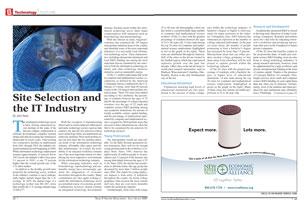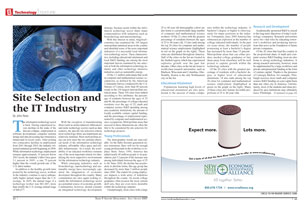
 The information technology sector is back. Having experienced severe declines in the wake of the dotcom collapse, employment in software development, computer systems design, and data processing has witnessed a turnaround in recent years. After posting two consecutive declines in employment from 2001 through 2003, the industry witnessed sustained growth beginning in 2004. While information technology employment remains approximately 10 percent below 2001 levels, the industry's labor force grew 3.1 percent in 2005—a rate 75 percent higher than the overall growth rate of the U.S. labor market.
The information technology sector is back. Having experienced severe declines in the wake of the dotcom collapse, employment in software development, computer systems design, and data processing has witnessed a turnaround in recent years. After posting two consecutive declines in employment from 2001 through 2003, the industry witnessed sustained growth beginning in 2004. While information technology employment remains approximately 10 percent below 2001 levels, the industry's labor force grew 3.1 percent in 2005—a rate 75 percent higher than the overall growth rate of the U.S. labor market.
In addition to the healthy growth rates posted by the technology sector, workers in the industry continue to enjoy substantially higher annual wages than the U.S. average. In 2005, the annual wage of a technology worker was $81,447, more than double the U.S. average annual wage of $40,677.
With the exception of manufacturing firms (such as semiconductors fabricators) and niche technology sectors (such as data centers), the specific site selection most technology firms are relatively minimal. The two primary physical needs of the information technology industry—affordable office space and reliable infrastructure—can now be met by most metropolitan areas. As a result, the availability of an educated workforce remains one of the most important criteria for identifying the most supportive environments for the information technology industry.
While emerging industries such as biotechnology, nanotechnology, and sustainable energy have increasingly captured the imagination of economic developers throughout the country, many communities are again looking towards the information technology sector as a potential source of economic growth. Communities, however, should consider an integrated technology development strategy, because needs within the information technology sector share many commonalities with industries such as biotechnology and nanotechnology.
With this interest in mind, Angelou Economics has examined the 100 largest metropolitan statistical areas in the country and identified some of the more important indicators of a successful local information technology sector. These characteristics, including educational attainment and local R&D funding, are among the most important factors examined by site selectors in both the information technology industry and other technology intensive industries such as sustainable energy.
Of the 3.1 million individuals that work in computer and mathematical science occupations as defined by the American Community Survey conducted by the U.S. Bureau of Census, more than 80% reside in the 100 largest metropolitan statistical areas. These 100 cities were ranked according to five attributes: the percentage of residents between the ages of 25 and 44, the percentage of college-educated residents over the age of 25, math and computer science R&D spending among area academic institutions, the amount of locally available venture capital funding, and the percentage of employment represented by computer and mathematical science occupations. Metropolitan areas that succeed in these dimensions are often the first to be considered by site selectors for technology projects.
Young Professionals
The demographic trends are unavoidable. As the Baby Boomer generation enters retirement, there will not be enough young professionals in the workforce to replace them. Since 1990, America has added nearly 40 million people to its population; just 3.2 percent of the increase was among individuals between the ages of 25 to 44. Since 2000, the decline has accelerated; in absolute terms, this age-group has decreased by more than 3 million people since 2000. The crunch for young employees impacts a wide array of industries throughout the county. As recent college graduates often possess the most current skill sets, however, they are even more desirable within the technology industry.
Unsurprisingly, most cities with a large 25 to 44 year old demographic cohort are also home to a proportionally large number of computer and mathematical science workers. Of the 21 cities with the greatest percentage of residents between the ages of 25 to 44 years old, 15 also rank among the top 20 cities for computer and mathematical science employment. These cities are distributed throughout America. Half of the cities on the list are located in the Sunbelt region, which has experienced explosive growth over the past few decades. Other cities on the list are home to world class research universities, such as Madison, Wisconsin and Columbus, Ohio. Notably, Boston is the only Northeastern city on the list.
Educational Attainment
Populations featuring high levels of educational attainment are also paramount to the success of many companies within the technology industry. A bachelor’s degree or higher is often requisite for many positions in the industry. Fortunately, since 2000 America has witnessed an explosion in the number of college educated individuals. In the past six years alone, the number of people possessing at least a bachelor’s degree has increased by more than15 percent. Metropolitan areas that can either produce needed college graduates or lure them away from elsewhere will be well poised to capture growth within the technology industry.
Of the 20 cities with the greatest percentage of residents with a bachelor degree or higher level of educational attainment, 14 also rank among the top 20 cities for computer and mathematical science employment. Many of these cities also feature favorable proportions of 25 to 44 year olds.
Research and Development
Academically-sponsored R&D is crucial to the long-term objectives of today’s technology companies. Research universities serve two vital roles by educating tomorrow’s workforce and producing innovations that serve as the foundation of future private companies.
Of the 20 cities that lead the country in the proportional share of math and computer science R&D funding, most are also home to strong technology industries. A strong research university, however, must be supplemented by a large workforce and private entrepreneurial funding in the form of venture capital. Thanks to the presence of Carnegie Mellon, for example, Pittsburgh receives more math and computer science R&D funding on a per capita basis than any other city in America. Unfortunately, most of the students and ideas produced by area institutions such ultimately leave Pittsburgh. Lycos, for example, was first developed at Carnegie Mellon. Ultimately, however, the company relocated to Boston due to the availability of venture capital funding and a highly educated workforce.
Venture Capital
The availability of local venture capital fosters the creation of innovative technology companies. If research universities fund the exploration of infant technologies, venture capital networks provide financing to individuals who can manage these technologies as they develop through adolescence and into mature, commercially viable enterprises. Unfortunately, most communities must develop local technology sectors in the absence of large amounts of venture capital.
Currently, technology venture capital is overwhelmingly concentrated in a few cities. Combined, San Jose, Boston, and San Francisco, receive nearly half of all the available technology venture capital in America. Still, the majority of cities with the largest share of mathematical and computer science employment do enjoy some level of venture capital funding. In areas without large research institutions, such as Portland, venture capital can help compensate for the relative lack of academic R&D.
Technology Employment
Most of the 20 metropolitan areas with the highest ratio of workers in computer and mathematical occupations also feature prominently in other examined areas such as educational attainment and the availability of venture capital funding. Four of the top five metropolitan areas for technology employment rank among the top 20 in all other examined attributes.
Several metropolitan areas such as Kansas City and Albany, however, have succeeded in establishing significant technology workforces without the presence of research universities, large young professional populations or venture capital funding. Nearly all of these cities, however, enjoy relative proximity to other top technology metropolitan area. Harrisburg, Pennsylvania for example, is within a few hours drive of both Washington, DC and Baltimore. Cities such as Harrisburg often feature lower costs of living and other benefits, allowing workers to migrate to these communities while remaining in close contact to many of the resources present in top technology metropolitan areas.
The Cumulative Effects of Success
Although some communities have successfully lured technology companies without the benefit of young professionals, highly educated populations, major research universities, or plentiful venture capital markets, the cumulative advantages of these factors is unmistakable. Six metropolitan areas in America score among the top 20 in all examined areas—Atlanta, Austin, Boston, San Jose, Raleigh, and Washington D.C. On a weighted-average basis, 5.1 percent of employment in these metropolitan areas is in computer and mathematical occupations. An additional five metropolitan areas rank within the top 20 on three of the four examined factors, including Denver, Madison, Minneapolis, San Francisco, and Seattle. Among these communities, an average of 4.3 percent of the workforce is engaged in computer and mathematical occupations.
Clearly, communities should not intend to develop each of the examined indicators in isolation. In metropolitan areas that rank within top twenty on two or fewer examined attributes, on average just 2.4 percent of their workforces are engaged in computer and mathematical employment. Metropolitan areas that rank within the top 20 on one or two categories might best dedicate their resources towards gaining ground in the other examined areas. The majority of communities, however, must instead identify niche sectors in which they have distinct strengths.
Sources
Percentage of Population between the Ages of 25 and 44: American Community Survey, 2005
Percentage of Population over the Age of 25 with a Bachelor Degree or Higher Level of Education: American Community Survey, 2005
Percentage of Workforce in Mathematical and Computer Science Occupations: American Community Survey, 2005
Venture Capital Financing: MoneyTree Report, PricewaterhouseCoopers and the National Venture Capital Association, 2006. Technology-related industries included Software, Semiconductors, IT Services, Networking & Equipment, Telecommunications, and Electronics.
Math and Computer Science R&D Funding: National Science Foundation, 2004.

